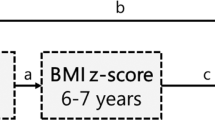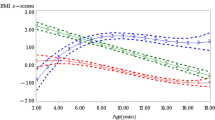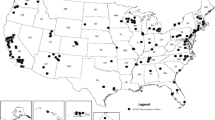Abstract
Background:
The evacuation and disruption in housing caused by the 2011 Great East Japan Earthquake and following nuclear radiation may have influenced child health in many respects. However, studies regarding longitudinal childhood growth are limited. Therefore, in this study we aimed to explore the influence of the earthquake on longitudinal changes in body mass index in preschool children.
Methods:
Participants were children from nursery schools who cooperated with the study in the Iwate, Miyagi and Fukushima prefectures. The exposed group consisted of children who experienced the earthquake during their preschool-age period (4–5 years old). The historical control group included children who were born 2 years earlier than the exposed children in the same prefectures. Trajectories regarding body mass index and prevalence of overweight/obesity were compared between the two groups using multilevel analysis. Differences in the changes in BMI between before and after the earthquake, and proportion of overweight/obesity was compared between the two groups. We also conducted subgroup analysis by defining children with specific personal disaster experiences within the exposed group.
Results:
A total of 9722 children were included in the study. Children in the exposed group had higher body mass indices and a higher proportion of overweight after the earthquake than the control group. These differences were more obvious when confined to exposed children with specific personal disaster experiences.
Conclusions:
Children’s growth and development-related health issues such as increased BMI after natural disasters should evoke great attention.
This is a preview of subscription content, access via your institution
Access options
Subscribe to this journal
Receive 12 print issues and online access
$259.00 per year
only $21.58 per issue
Buy this article
- Purchase on Springer Link
- Instant access to full article PDF
Prices may be subject to local taxes which are calculated during checkout



Similar content being viewed by others
References
National Geophysical Data Center. Significant Earthquake. 2011. Available at: http://www.ngdc.noaa.gov/nndc/struts/results?eq_0=9799&t=101650&s=13&d=22,26,13,12&nd=display.
National Geophysical Data Center. Great Tohoku, Japan Earthquake and Tsunami. 2011. Available at: https://www.ngdc.noaa.gov/hazard/11mar2011.html.
Virdis A, Ghiadoni L, Masi S, Versari D, Daghini E, Giannarelli C et al. Obesity in the childhood: a link to adult hypertension. Curr Pharm Des 2009; 15: 1063–1071.
Chang CJ, Jian DY, Lin MW, Zhao JZ, Ho LT, Juan CC . Evidence in obese children: contribution of hyperlipidemia, obesity-inflammation, and insulin sensitivity. PLoS One 2015; 10: e0125935.
Cockrell Skinner A, Foster EM . Systems science and childhood obesity: a systematic review and new directions. J Obes 2013; 2013: 129193.
Matsubara H, Ishikuro M, Kikuya M, Chida S, Hosoya M, Ono A et al. Design of the Nationwide Nursery School Survey on Child Health throughout the Great East Japan Earthquake. J Epidemiol 2016; 26: 98–104.
Ministry of Education, Culture, Sports, Science and Technology (MEXT). Japanese School Health Statistics. Available at: www.mext.go.jp/b_menu/toukei/chousa05/hoken/1268826.htm.
Cole TJ, Bellizzi MC, Flegal KM, Dietz WH . Establishing a standard definition for child overweight and obesity worldwide: international survey. BMJ 2000; 320: 1240–1243.
Waring SC, Brown BJ . The threat of communicable diseases following natural disasters: a public health response. Disaster Manag Response 2005; 3: 41–47.
Kako M, Arbon P, Mitani S . Disaster health after the 2011 great East Japan earthquake. Prehosp Disaster Med 2014; 29: 54–59.
Iwadare Y, Usami M, Suzuki Y, Ushijima H, Tanaka T, Watanabe K et al. Posttraumatic symptoms in elementary and junior high school children after the 2011 Japan earthquake and tsunami: symptom severity and recovery vary by age and sex. J Pediatr 2014; 164: 917–921 e1.
Osawa M . Earthquake disaster footage and its effects on children: request to the media to help protect children. Brain Dev 2013; 35: 188–189.
Aldrich N, Benson WF . Disaster preparedness and the chronic disease needs of vulnerable older adults. Prev Chronic Dis 2008; 5: A27.
Tsubokura M, Takita M, Matsumura T, Hara K, Tanimoto T, Kobayashi K et al. Changes in metabolic profiles after the Great East Japan Earthquake: a retrospective observational study. BMC Public Health 2013; 13: 267.
Onose T, Nochioka K, Sakata Y, Miura M, Tadaki S, Ushigome R et al. Predictors and prognostic impact of post-traumatic stress disorder after the great East Japan earthquake in patients with cardiovascular disease. Circ J 2015; 79: 664–667.
Koshino T, Morii T, Wada J, Takahashi S . Unicompartmental replacement with the marmor modular knee: operative procedure and results. Bull Hosp Jt Dis Orthop Inst 1991; 51: 119–131.
Murakami H, Yoshimura E, Ishikawa-Takata K, Nishi N, Tsuboyama-Kasaoka N, Yokoyama Y . The longitudinal change in physical activity among Great East Japan Earthquake victims living in temporary housing. Nihon Koshu Eisei Zasshi 2014; 61: 86–92.
Kishimoto M, Noda M . The Great East Japan Earthquake: experiences and suggestions for survivors with diabetes (perspective). PLoS Curr 2012; 4: e4facf9d99b997.
Inoue T, Nakao A, Kuboyama K, Hashimoto A, Masutani M, Ueda T et al. Gastrointestinal symptoms and food/nutrition concerns after the great East Japan earthquake in March 2011: survey of evacuees in a temporary shelter. Prehosp Disaster Med 2014; 29: 303–306.
Nishi N, Yoshimura E, Ishikawa-Takata K, Tsuboyama-Kasaoka N, Kubota T, Miyachi M et al. Relationship of living conditions with dietary patterns among survivors of the great East Japan earthquake. J Epidemiol 2013; 23: 376–381.
Acknowledgements
We would like to thank the participants for providing their information and the staff of the participant nursery schools for their efforts during the data collection. This study is a part of a surveillance study of child health in the Great East Japan Earthquake disaster area (Health Labour Sciences Research Grant, Principal investigator is Shigeo Kure).
Author information
Authors and Affiliations
Corresponding author
Ethics declarations
Competing interests
The authors declare no conflict of interest.
Rights and permissions
About this article
Cite this article
Zheng, W., Yokomichi, H., Matsubara, H. et al. Longitudinal changes in body mass index of children affected by the Great East Japan Earthquake. Int J Obes 41, 606–612 (2017). https://doi.org/10.1038/ijo.2017.6
Received:
Revised:
Accepted:
Published:
Issue Date:
DOI: https://doi.org/10.1038/ijo.2017.6
This article is cited by
-
Prolonged body weight gain, lifestyle changes and health-related quality of life in children during the COVID-19 pandemic lockdown: A follow-up study
European Journal of Clinical Nutrition (2023)
-
Metagenomic analysis reveals associations between salivary microbiota and body composition in early childhood
Scientific Reports (2022)
-
Age- and weight group-specific weight gain patterns in children and adolescents during the 15 years before and during the COVID-19 pandemic
International Journal of Obesity (2022)
-
Consequences of atmospheric contamination by radioiodine: the Chernobyl and Fukushima accidents
Endocrine (2021)
-
Long-term effects of adolescent obesity: time to act
Nature Reviews Endocrinology (2018)



